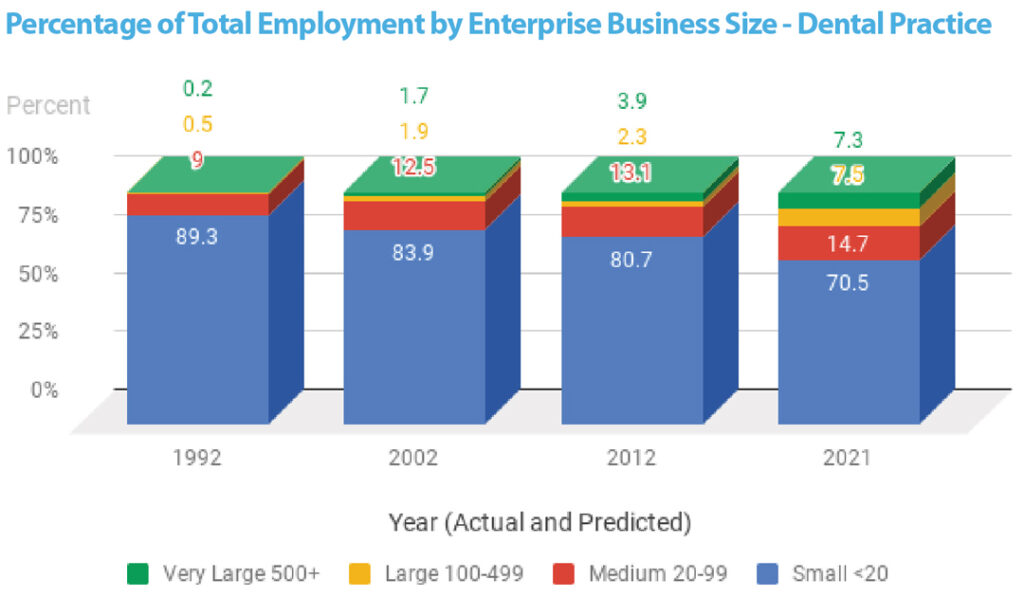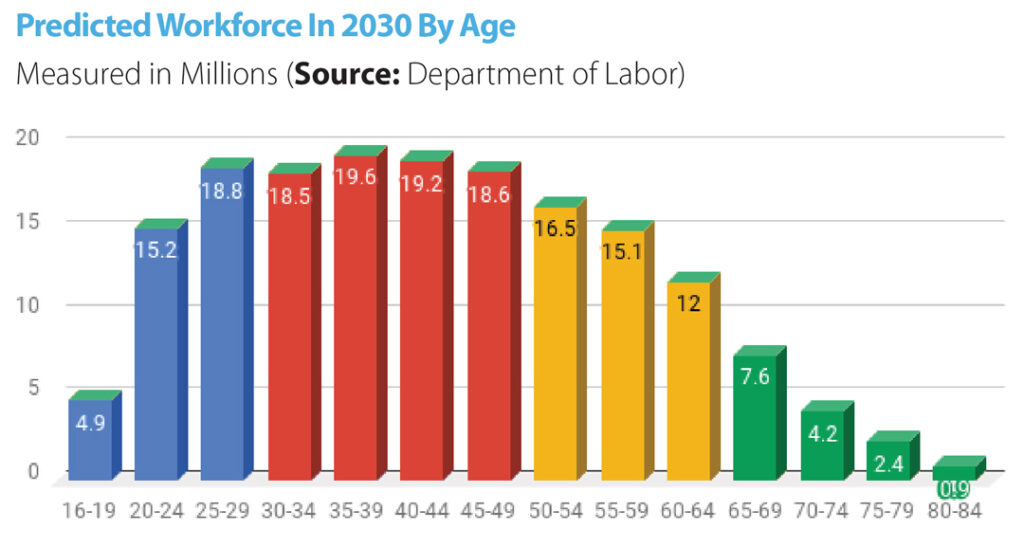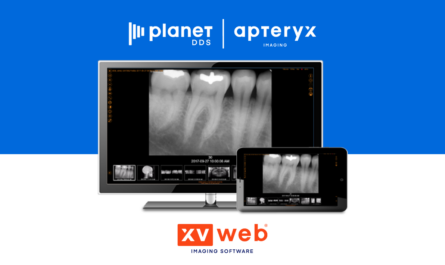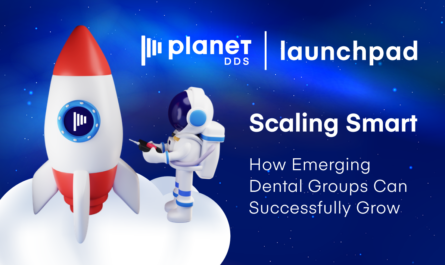12 undeniable future trends in group dentistry that will impact your growth.
What is one thing that most growing businesses have in common? They look at trends and look towards the future when implementing strategies in order to facilitate growth and to prevent failure (Fail Example: Blockbuster did not get into streaming). The same is true in the dental industry. Group practices looking to grow must take advantage of trends, and they must make the future work for them, not against them. Fortunately, we (The DEO) are giving you a chance to prepare, and potentially take advantage of these trends with the following insights.
1. Dental Industry Consolidation Likely to Accelerate
It’s no surprise that the dental industry is consolidating. That said, the rate at which consolidation will occur in the near future is something worth noting. Large groups / DSOs have seen about 15% growth over the past decade; however, forecasts predict that this same growth rate will be seen in a far shorter time frame.1 More specifically, this 15% growth rate is likely to be achieved in the next 5 years rather than the previous growth period of 10 years. This indicates a potential market consolidation rate of 30% by 2021.
Why this is important: As the industry keeps consolidating, groups that decide to grow may fare better than smaller groups. Larger groups (> 3-4 locations) will have more bargaining power for supplies, they’ll offer more security to incoming associates, and they’ll likely have more in-tuned systems among many other things. As the trend grows, the competitive advantages of the multi-location / DSO model are likely to put downward pressure on single location, mom-and-pop practices.

2. Traveling Specialists and In-House Specialty Procedures
Again, in response to reducing insurance reimbursements and increasing competition, practices small and large are finding ways to improve financial performance, one way being bringing specialty procedures in house. According to Synergy Specialists, 60% of patients referred out of the practice never end up proceeding with specialty care. The 40% that actually commit to treatment end up converting another 60% to restorative treatment.2 As such, the days of referring out dentistry are diminishing. Groups are starting to bring in travelling specialists and/or are training general dentists to perform specialty procedures. Some estimates predict that more than 50% of dental treatments related to extractions and implant cases are expected to be performed in the private practices of general dentists within the next 10 years.3
3. Private Equity Will Continue to Pour Money into Dental
Investor capital is expected to pour into the dental industry as consolidation continues to occur. Private equity firms are drawn to efficiencies that chains (Multi-location and DSOs) can bring to individual dental practices, which these days require sophisticated marketing and expensive technology. Less than 10% of dentists are affiliated with corporate-backed practices, according to the American Dental Association, so there’s a lot of room for consolidation and subsequent investors to get into the space.4 Moreover, according to Karan Garg at Houlihan Lokey, there’s still around $1 trillion available for investment in private equity. Estimated at $130 billion, the DSO market is larger than urgent care, physical therapy, dermatology, and the veterinary space combined. This indicates that DSOs are attractive investments and are likely to see extensive funding from that $1 trillion in private equity capital in the coming years.
Why this is important: Private equity may accelerate the rate in which consolidation occurs. Investor money and resources will give groups more leverage to expand and/or build efficiencies in their business. Growing groups can take advantage of this trend, whereas the increased rate of consolidation is likely to put downward pressure on single-location practices.
4. Virtual Dentistry
As society continues to move toward a digital landscape, opportunistic groups are starting to take advantage of teledentistry, and it’s a trend that’s likely here to stay. Using technology, dental professionals can screen, record, triage, diagnose, and order care to be performed remotely. Furthermore, many insurance providers, including Medicaid, cover teledentistry services. As was the case with dental kiosks, teledentistry makes it easier for people to receive dental services without actually having to visit the dentist. According to the American TeleDentistry Association, recent studies on the use of telehealth services have shown that 70% of patients are comfortable communicating with their healthcare providers via text, email or video in lieu of seeing them in person, and 76% of patients prioritize access to care over the needs for face-to-face interactions with their healthcare providers. In fact, 30% of patients already use computers or mobile devices to check for medical or diagnostic information.5
5. Generational Shift in the Workforce
This trend is more universal; however, its effects in dentistry will be substantial. It’s estimated that by 2025, millennials will make up 75% of the workforce.7
Why this is important: This is important to know as a group practice owner because it should change the way you think about hiring and retaining staff, especially millennial associates. Millennials value things like sense of purpose, personal development, flexibility, etc. If you find a way to integrate these values into your business, you might be able to retain staff and associates better during this generational shift in the workplace.

6. Women in Dentistry on the Rise
This trend has been steadily increasing for a while now, and it shows no signs of slowing down. From 2001 to 2017, the percent of practicing female dentists rose from 16% to 31% and is continually increasing.8 Additionally, more women are taking leadership and ownership roles in the profession than ever before. As gender equality programs such as parental rather than maternal leave become more popular, women are finding it easier to balance work and family life. Additionally, the rise of strategic partnerships with DSOs and DMOs takes non-dental related tasks and burdens off the plate of practice owners, allowing for more flexibility.
Why this is important: As noted in trend No. 6, millennials will dominate the workforce by 2025. So, not only is the quantity of women in dentistry increasing, but the quantity of women who have young families, or are at the age of starting a family, will also be increasing. Practice owners that accommodate for this (Daycares, good PTO, parental leave, etc.) may fare better in the future when hiring and retaining quality associates.
7. Young Dentists Working for Larger Groups
As discussed earlier, the share of total employees, including associates, in the dental industry is shifting from single practice locations to larger group practices (20% as of 2012) and this trend is only getting larger. Dental school tuition is rising rapidly and consistently. As such, young associates are looking for positions that offer security and benefits to combat these rising costs. Larger groups are typically better positioned to provide this sense of stability to associates than smaller groups and will have more bargaining power when it comes to hiring as a result.
8. 3D Printing Takeover
3D printing in dentistry is already taking off. Over $4 billion worth of dental parts were printed using 3D printing in 2017, and 3D printer sales to the dental industry grew 75% in 2016 over 2015.9 3D printing is inexpensive and fast to the point where manufacturing jobs are beginning to come back from overseas as a result. The 3D printing trend is already underway and will likely only become more substantial as time goes on.
Why this is important: 3D printing may be a polarizing trend in the dental industry as it becomes (if it isn’t already) faster, cheaper, and just as effective as traditional methods. Take this scenario for example: If a dental practice is still doing night guard impressions with a turnaround time of weeks, but other local practices are scanning and 3D-printing the same night guards in 45 minutes (potentially at a lower cost), chances are consumers will begin to migrate to those more efficient groups over time.
9. Artificial Intelligence in Dentistry
Many forecasts predict that Artificial Intelligence (AI) will be completely woven into the dental landscape by 2030 – and maybe even before.10 AI has the potential to unlock clinically relevant information hidden in relatively massive amounts of data, which in turn can assist in clinical decision-making. Additionally, AI can autonomously learn from this data to continuously improve accuracy in decision-making. AI will also be able to measure outcomes, reporting which dentist delivers the best outcomes.
Why this is important: AI will have to overcome data and privacy barriers as well as hesitation regarding machine-based decision making before it becomes universally accepted; however, as an owner, proper implementation of AI could drastically improve the efficiency in the way your practice(s) diagnoses and treats dentistry. Additionally, AI will be able to act as an Associate assessment tool that can track performance & determine pay.
10. Robotics Becoming Mainstream
Many industries have already integrated robotics into their systems, and dentistry is not far behind. Contrary to the popular belief about robotics in general, robotics in dentistry is far from replacing the humans; rather, the technology is moving towards complimenting dentists in a way that makes their ability to practice dentistry easier, more efficient, and more effective. Here are a few examples of robotics that have already made their
way into, or are being tested in the dental industry1:
- Training robots – Use cameras and sensors to evaluate student performance.
- Endo micro robots – Perform root canals more efficiently than traditional methods by reducing overzealous tooth removal and inadequate openings.
- Dental nanobots – Multi-application robots that can assist in orthodontics, sensitivity, tooth blemish control, etc.
- Surgical robots – A surgical robot system for maxillofacial surgery that works in conjunction with surgeon programming.
11. Evidence-Based Dentistry
Evidence-based dentistry (EBD) is not a new phenomenon; however, it’s adoption is likely to be more widespread in the coming future. EBD integrates the dentist’s clinical expertise, the patient’s needs and preferences, and the most current, clinically relevant evidence to make decisions. Patient needs and dentist clinical experience have been ascertained relatively easily in both the past and present; however, current, relevant scientific evidence has taken a while to catch up. That is, scientific evidence in the past was difficult to procure, and was thus very expensive. As the digital age evolves and things like cloud computing, AI, and blockchain continue to make strides in their adoption, it’s becoming easier to produce relevant scientific evidence in dental.11 As such, not only will EBD become more cost-friendly, but it will also become more accurate than ever before.
Why this is important: As is the case with Artificial Intelligence, EBD will improve the efficiency and outcomes of dental procedures; which, in turn, will result in more satisfied patients and potentially more business through referrals. Granted, EBD decreases the human element in decision making, which may result in some push back; however, those that adopt EBD will have vast amounts of data that will either support or refute their decisions. This will mitigate the chances of making mistakes and will increase the chances of providing proper treatment.

12. Medical Dental Integration
As dentistry continues to consolidate, large group and DSO business models are starting to reflect structures and business models in healthcare. These newfound structural similarities are beginning to open opportunities for the integration of health and dental.
Why this is important: Here are some outcomes of integrated health and dental structures according to Dr. John Snyder, CEO and Dental Director at Kaiser Permanente (One of the few fully integrated health and dental organizations.)
Overall health improvements: Integrating health and dental provides a more full-service experience for patients. For example, there are many oral health issues that accompany diabetes; however, many people with diabetes just go to the doctor. An integrated model would give diabetics, who only intended on going to the doctor, an opportunity to get their diabetic oral issues addressed. As such, large adoption of integrated models could lead to a healthier general public.
Referral network: The financial side of improved overall health is the referral aspect of the integrated model. If somebody goes to the doctor but also needs dental care (and vice-versa), there’s a greater probability that he/she will take advantage of dental services when prompted since it’s conveniently all in-house and likely covered by the same insurance plan. Integrated models have the mutual benefit of a doctor to dentist and dentist to doctor marketing referral network.
Cost and convenience: Integrated models allow for the joint leveraging of technologies, human assets, and physical assets between the health and dental sides of the business. This lowers the financial burden for both parties under the single, greater entity.
Sources
1. “Dental Practice Transitions: Consolidation vs. Sole Proprietors.” Henry Schein, 17 July 2018, dentalpracticetransitions.henryschein.com/blog-dental-practice-transitions-consolidation-vs-solo-practitioners.
2. “Is It Time to Bring an In-House Specialist to YOUR Office?” Synergy Specialists, Synergy Specialists, 12 Sept. 2018, synergyspecialists.com/bring-house-specialist-office-new-paradigm.
3. “Traveling Dental Specialist Trend Growing, Helps Dentists Keep Treatment in-House January 16, 2017.” Dentistry IQ, Jan. 2017, www.dentistryiq.com/articles/2017/01/traveling-dental-specialist-trend-growing-helps-dentistskeep-treatment-in-house.html.
4. Mathis, Will, and Tom Metcalf. “Private Equity Is Pouring Money Into a Dental Empire.” Bloomberg.com, Bloomberg, June 2018, www.bloomberg.com/news/articles/2018-06-28/wall-street-transforms-dentistry-into-a-creditfueled-gold-rush.
5. American TeleDentistry Association, “Facts About Teledentistry”, www.americanteledentistry.org/facts-about-teledentistry.
6. Salierno, Chris. “4 Ways Cloud Computing Will Change Dentistry for the Better.” DentistryIQ, DentistryIQ, 10 Jan. 2012, www.dentistryiq.com/articles/2012/01/4-ways-cloud-computing-will-change-dentistry-for-the-better.html.
7. 2017 Global Workplace Trends. Sodexo, 2017, www.sodexo.com/files/live/sites/sdxcomglobal/files/PDF/Media/Sodexo-2017-workplace-trends-report.pdf.
8. Solana, Kimber. “Women in Dentistry See Progress, Continued Challenges.” American Dental Association, Jan. 2016, www.ada.org/en/publications/ada-news/2016-archive/january/women-in-dentistry-see-progress-continuedchallenges.





